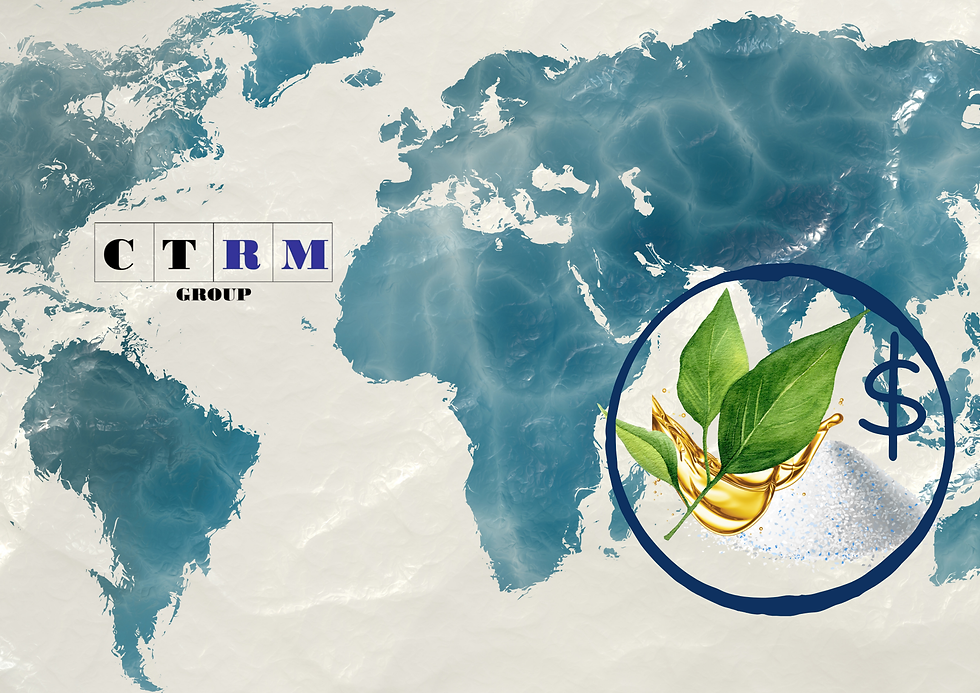Regulation Watch: How New FDA / EU / Global Rules Are Changing Ingredient Use
- CTRM Group

- Oct 1
- 4 min read
Regulatory scrutiny on ingredients has accelerated. From FDA actions on food additives and U.S. cosmetics reforms to new EU hazard classes, microplastics restrictions, and deforestation-free supply chain rules, formulation and labeling decisions now carry higher compliance stakes and deadlines.

What’s new
(and why it matters)
U.S. | FDA (Food): BVO banned with a phase-out clock
FDA finalized its rule revoking brominated vegetable oil (BVO) in foods. Effective Aug 2, 2024, with a one-year compliance period for reformulation and relabeling (enforcement begins Aug 2025). Federal Register+2U.S. Food and Drug Administration+2
U.S. | FDA (Cosmetics): MoCRA is in force
Facilities must register with FDA and renew every two years; product listing is required. Additional rulemakings are queued (e.g., fragrance-allergen disclosure; cosmetics GMP). U.S. Food and Drug Administration+2Covington & Burling+2
EU | CLP: New hazard classes drive re-classification & labels
The EU added new hazard classes (e.g., endocrine disruptors; PBT/vPvM). New substances must comply by May 1, 2025; mixtures follow later transition dates (e.g., Nov 1, 2026, with further phase-ins). Expect SDS/label updates. ECHA+2Sustainability in Business+2
EU | REACH: Microplastics restriction is rolling out
The EU adopted a broad restriction on intentionally added microplastics (e.g., loose glitter, microbeads), with staged bans and information duties starting in 2023–2025. Suppliers of synthetic polymer particles face new instructions/disclosure obligations from Oct 17, 2025. ECHA+2Internal Market & Industry+2
EU | REACH: SVHC Candidate List keeps growing
ECHA continues to add substances of very high concern (SVHCs)—247+ entries as of 2025—raising authorization/communication duties and substitution pressure. ECHA+1
EU | Deforestation-free products (EUDR): Traceability for certain commodities
The EU’s deforestation regulation applies Dec 30, 2025 for medium/large companies and Jun 30, 2026 for SMEs, requiring due-diligence statements and geolocation traceability for listed commodities and derivatives (e.g., palm oil, cocoa, coffee, rubber, soy, wood). (Recent updates confirm the 2025/2026 timing and additional guidance.) Cassidy Levy Kent+3Environment+3Green Forum+3
UK | REACH (post-Brexit): Diverging timelines
The UK is consulting on further extensions to transitional registration deadlines beyond the current Oct 2026/2028/2030 milestones. If you supply into GB, watch for divergence vs. EU REACH. Norton Rose Fulbright+4GOV.UK+4consult.defra.gov.uk+4
China | Cosmetics: Tightening label & safety expectations
NMPA continues to refine cosmetic safety assessment and fragrance-allergen labeling guidance; ensure China-specific labeling and dossier readiness for cross-border sales. cisema.com+1
How these rules change day-to-day ingredient use
Formulation selection & allowable limits: New hazard classes and SVHC listings can trigger substitutions, lower use levels, or phase outs especially for intentionally added microplastics and certain preservatives/plasticizers. ECHA+1
Labeling & documentation: Expect refreshed SDS and labels (EU CLP), cosmetic product labels with potential fragrance-allergen disclosures (MoCRA roadmap), and deforestation due-diligence statements for commodity-linked ingredients. Sustainability in Business+2Covington & Burling+2
Market-specific divergence: EU REACH vs. UK REACH deadlines and China NMPA rules mean a single formulation/label may no longer be universally compliant without localization. HSE+2GOV.UK+2
Stay compliant: a quick checklist
Map your portfolio
Tie every SKU to a current ingredient list, supplier CoAs, SDS, and region of sale. Flag any use of synthetic polymer particles (EU), commodity-linked ingredients (EUDR), or SVHCs. ECHA+1
Screen ingredients against live lists
Check EU CLP new hazard classes and ECHA SVHC updates before reformulations or new launches. Build automated alerts. ECHA+1
Revise labels/SDS early
Prioritize products selling in the EU (CLP re-classification timelines) and U.S. cosmetics (MoCRA changes), plus any BVO clean-up for U.S. foods (if relevant). Sustainability in Business+2U.S. Food and Drug Administration+2
Stand up due-diligence for EUDR
For palm oil, coffee, cocoa, rubber, soy, wood (and derivatives), prepare geolocation data, risk assessment, and a due-diligence statement prior to the 2025/2026 application dates. World Resources Institute+1
Mind market divergence
If you sell into GB (UK REACH) or China (NMPA), maintain separate compliance tracks for registration/labeling. HSE+1
Common pitfalls (and how to avoid them)
Assuming EU ≈ UK: Missing UK-specific REACH timelines or documentation can stall GB sales. Track both. HSE
Overlooking mixture timelines: CLP deadlines differ for substances vs. mixtures don’t update one without the other. Sustainability in Business
Microplastics “by another name”: Some polymer particles aren’t called “microplastics” on specs—verify definitions (size/solubility/biodegradability) against the EU restriction text. Internal Market & Industry+1
Late label updates: Waiting until enforcement dates risks sell-through issues and relabeling waste. Start change control now (especially for MoCRA and CLP). U.S. Food and Drug Administration+1
Commodity traceability gaps: EUDR requires geolocation and legality evidence. If you use palm-based materials, align suppliers and data systems early. World Resources Institute
How CTRM supports your compliance journey
Proactive sourcing & specs We qualify suppliers with up-to-date CoAs, regulatory attestations, microplastics declarations, and deforestation-free claims where applicableso you’re starting from a stronger file.
Regulatory watch & alerts Our team monitors FDA (food & cosmetics), EU REACH/CLP, UK REACH, and China NMPA updates and flags affected ingredients in your purchase history before deadlines hit. ChemLinked+4Federal Register+4U.S. Food and Drug Administration+4
Label/SDS handoff readiness We provide harmonized ingredient documentation (INCI/CAS, use levels, known restrictions, hazard classes) to accelerate your SDS, label, and regulatory dossier updates aligned to each market. ECHA
Substitution pathways If an ingredient becomes constrained (e.g., due to SVHC status or microplastics rules), we source functionally equivalent alternatives and share trial data from our network. ECHA+1
Traceability enablement (EUDR) For commodity-linked inputs (e.g., palm derivatives), we help collect supplier geolocation and legality information and integrate it into your due-diligence workflow. World Resources Institute
What to do this quarter
Run a rapid portfolio screen for microplastics, SVHCs, and commodity-linked ingredients.
Lock your change-control calendar for EU CLP re-class dates and MoCRA deliverables.
Engage suppliers on EUDR traceability and China labeling (if selling there).
Schedule reformulation trials where substitutions are likely.
Need a head start? CTRM can provide a tailored Regulatory Impact Summary for your ingredient set, plus a prioritized action plan (labels/SDS, substitutions, and supplier due-diligence). Let us know your target markets and SKUs we’ll take it from there.





Comments